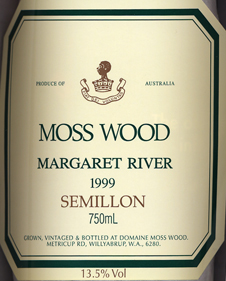Moss Wood 1999 Semillon

Wine Facts
| Harvested: | 15/3/1999 |
| Bottled: | 27/7/1999 |
| Released: | 09/9/1999 |
| Baume: | 13.10 |
| Alcohol: | 13.50% |
| Vintage Rating: | 9/10 |
SOLD OUT
Tasting Notes
The 1999 Moss Wood Semillon has quite restrained granny-smith apple and fig aromas with some minerally notes in the background. It is clean and lively, soft initially, mouthfilling, with granny-smith, fig and tobacco flavours and some earthy, minerally notes. The finish shows fresh acidity with firm, though not bitter, grape tannins lingering. Although attractive early drinking, this is a white wine of substance: impressive weight, tight structure and full bodied flavour.
We see it as a refinement of the Moss Wood style with a touch more complexity probably from the use of wild yeast, although it appears that maturation on lees and battonage (lees stirring) are also factors.
Vintage Notes
The 1999 harvest came at the end of a textbook growing season which featured good flowering conditions and consistently mild temperatures. Some vineyards in the region over cropped and consequently had problems ripening the semillon. This was not a concern at Moss Wood where reasonable yields allowed the finished wine to register 13.5% alcohol. The picking took place on lovely autumnal days and although rain threatened, none of consequence disrupted the harvest. The birds left Moss Wood alone so the grapes could ripen without the anybody's equilibrium being affected.
Production Notes
The treatment in the winery was similar to that of the previous year: the grapes were crushed, drained, pressed, cold settled and the juice was taken off. Two per cent solids were added to the stainless steel tank and fermentation was allowed to commence with indigenous yeast strains. When fermentation was approximately one quarter finished, the tank was seeded with pure yeast culture.
This sequential inoculation is designed to ensure that the nose and palate benefit from the interesting nuances derived from the wild yeast strains. A paper presented at the Technical Conference attended by the Clare and Keith, last year, suggested that most serious problems which accompany the use of indigenous yeasts would be avoided by the later addition of pure yeast: aroma and flavour are not adversely affected and incomplete fermentation is avoided. After being fermented to dryness, the wine was kept on its lees and stirred weekly for six weeks at which time it was protein stabilised, cold stabilised and bottled.
Cellaring Notes
Those with the opportunity to cellar well, are encouraged to do so for at least ten years.
